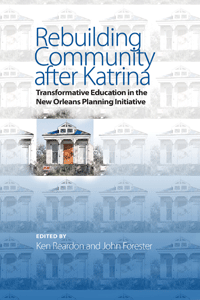Rebuilding Community after Katrina: Transformative Education in the New Orleans Planning Initiative

Rebuilding Community after Katrina compiles reflections on an unusual initiative. The ACORN-University Partnership (AUP) brought together a New Orleans community organization, ACORN, and a New York university, Cornell, to contribute to the city’s rebuilding in the months after Hurricane Katrina. The story is told by members of the Cornell team – students and faculty alike – who were instrumental to the project.
ACORN was then the biggest low-income community organization in the US, while Cornell is one of the most prestigious universities in the US. At ACORN’s request, the Cornell team began working on planning and design projects in the Ninth Ward of New Orleans. This led to a grant from the Rockefeller Foundation in partnership with the New Orleans Community Support Foundation, to develop plans for two of the city’s districts. The team mobilized community leaders and members, activists and academics, and private and nonprofit organizations.
It was a difficult policy climate, given the city’s limited planning capacity, the complex racial dynamics, and the belief of some powerful people that parts of New Orleans were not worth rehabilitating. As one white congressman commented, “We finally cleaned up public housing in New Orleans. We couldn’t do it, but God did.”
The Cornell planners became advocates for the rebuilding of the Ninth Ward, as their building conditions survey and living conditions survey showed that much of the building stock was in workable condition, and that the Ninth was far from the crime-engulfed, better-off-gone area many believed it to be. What resulted was The People’s Plan for Overcoming the Hurricane Katrina Blues. This plan, a deliberate alternative to the top-down plans that had predominated before then, received a good deal of media attention. Ultimately, the city council and city planning commission chose to integrate the main components of The People’s Plan into their comprehensive plan.
The book is frank in reflecting on power disparities and the challenges encountered along the way. These included different models of community organizing, such as activism vs. service delivery. There were also tensions between various organizations around the politics of who would be represented – not to mention competing priorities, such as national-level electoral work rather than local-level implementation. The fact that the book is edited by two Cornell professors, rather than members of ACORN, means that it focuses on the experiences of the university team.
Rebuilding Community after Katrina is also open about the personal experiences of those working on the plan. For instance, an Indian graduate student reflects on her prejudices and experiences of racism in the US, and how these inflected her work in New Orleans. The lessons she learned about participatory planning and community engagement, as well as the more personal transformations she experienced, are part of the transformative education mentioned in the book’s subtitle. In detailing AUP’s intersection of academic and on-the-ground work, the book argues for a more service-oriented approach to planning education.
But most important are the transformations (and failures to transform) of the city following the disaster. The words of returning Ninth Ward residents interviewed as part of AUP show a mixture of anger and hope in this regard:
“We are in the USA. We can go to Iraq and build them something, but we can’t build here? I don’t understand it. That’s scary.” (Betty Morgan)
“My life is invested in this Lower Ninth Ward. Everything I’ve learned and scuffled for I’ve put into buying me and my family a house that I didn’t think I deserved to give up on. And I don’t think we deserve for the powers in charge to give up on us. And that’s exactly what it feels like. It feels like they think we don’t deserve help.” (Deandra Carr)
“The thing that has come out of Katrina has shown me personally that people are good at heart, especially the young people…They’re turning out by the thousands to help us…And it has made me believe again in just how good we all could be if we just walk hand in hand instead of trying to pull everything apart as some people do.” (Rose Boitmann)
Further reading:
Archer, Diane and Somsook Boonyabancha (2011), “Seeing a disaster as an opportunity – harnessing the energy of disaster survivors for change”, Environment and Urbanization Vol 23, No 2, pages 351–364, available at http://eau.sagepub.com/content/23/2/351.abstract.
Nelson, Marla, Renia Ehrenfeucht and S Laska (2007), “Planning, Plans, and People: Professional Expertise, Local Knowledge, and Governmental Action in Post-Hurricane Katrina New Orleans”, Cityscape Vol 9, No 3, pages 23–52, available at http://papers.ssrn.com/sol3/papers.cfm?abstract_id=1090161.
Book note prepared by Christine Ro
Search the Book notes database
Our Book notes database contains details and summaries of all the publications included in Book notes since 1993 - with details on how to obtain/download.
Use the search form above, or visit the Book notes landing page for more options and latest content.
For a searchable database for papers in Environment and Urbanization, go to http://eau.sagepub.com/

